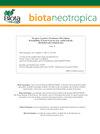Changes in sperm motility of amazonian fish Tambaqui Colossoma macropomum (Cuvier 1816) (Characiformes: Serrasalmidae) exposed to two pesticides
IF 1.2
4区 环境科学与生态学
Q3 BIODIVERSITY CONSERVATION
引用次数: 0
Abstract
Abstract The great biodiversity of neotropical fish species that have external fertilization as a reproductive strategy, like the tambaqui, requires more careful analyzes in toxicological tests of the various pesticides implemented in Brazilian agriculture over the last few years. In this context, the objective of the present work was to evaluate possible sperm alterations in tambaqui (Colossoma macropomum) semen exposed to two different pesticide residues. Seminal samples of sexually mature tambaqui males from a local fish farm were used. Semen was collected eight hours after hormone induction into graduated glass tubes. After initial assessment of the lack of prior activation, the experiment was carried out in a factorial scheme, testing two pesticides widely used in agricultural systems (glyphosate and fenitrothion). For each pesticide, five concentrations were tested (6, 12, 24, 120 and 240 mg/L), with motility analysis at times 0, 30 and 60 seconds after activation. As a control, activation with 0.9% NaCl solution and motility analysis at the same times described for pesticides were used. Results indicate that in natura samples exhibited initial motility of 89.2 ± 4.9% and mean duration of 100 seconds (up to 10% sperm motility). The reduction in sperm motility occurred significantly (p < 0.05) after 30 seconds in all concentrations tested, except for the concentration of 240 mg/L because no activation was observed. The tests described here demonstrate that tambaqui semen was sensitive to the process of exposure to pesticide residues, and can be used in biomonitoring analyzes of the aforementioned agricultural pesticides.两种农药对亚马逊河流域大尾鱼(Tambaqui Colossoma macropomum)精子活力的影响
以外部受精作为繁殖策略的新热带鱼类(如tambaqui)具有丰富的生物多样性,因此需要在过去几年中对巴西农业中使用的各种农药进行更仔细的毒理学测试。在这种情况下,本研究的目的是评估暴露于两种不同农药残留的tambaqui (Colossoma macropomum)精液中可能发生的精子变化。使用了来自当地养鱼场的性成熟坦巴基雄鱼的精液样本。精液在激素诱导后8小时被收集到刻度玻璃管中。在对缺乏事先激活进行初步评估后,实验以析因方案进行,测试了两种在农业系统中广泛使用的农药(草甘膦和杀虫硫磷)。对每种农药分别检测5种浓度(6、12、24、120和240 mg/L),并在激活后0、30和60秒进行动力学分析。作为对照,采用0.9% NaCl溶液活化,同时进行农药活性分析。结果表明,在自然条件下,精子的初始活力为89.2±4.9%,平均持续时间为100秒(精子活力高达10%)。除240 mg/L浓度外,其他浓度的精子活力均在30秒后显著降低(p < 0.05)。本文所述的试验表明,坦巴基精液对接触农药残留的过程很敏感,可用于上述农业农药的生物监测分析。
本文章由计算机程序翻译,如有差异,请以英文原文为准。
求助全文
约1分钟内获得全文
求助全文
来源期刊

Biota Neotropica
BIODIVERSITY CONSERVATION-
CiteScore
2.90
自引率
16.70%
发文量
0
审稿时长
4-8 weeks
期刊介绍:
BIOTA NEOTROPICA is an electronic, peer-reviewed journal edited by the Program BIOTA/FAPESP: The Virtual Institute of Biodiversity. This journal"s aim is to disseminate the results of original research work, associated or not to the program, concerned with characterization, conservation and sustainable use of biodiversity within the Neotropical region.
Manuscripts are considered on the understanding that their content has not appeared, or will not be submitted, elsewhere in substantially the same form, because once published their copyrights are transferred to BIOTA NEOTROPICA as established in the Copyright Transfer Agreement signed by the author(s).
 求助内容:
求助内容: 应助结果提醒方式:
应助结果提醒方式:


